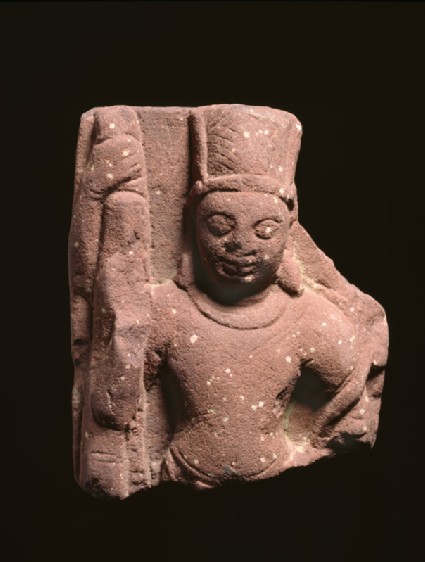Browse: 341 objects
- Reference URL
Actions
Relief fragment with Vishnu
-
Details
- Associated place
-
Asia › India › north India › Uttar Pradesh › Mathura district › Mathura (place of creation)
- Date
-
mid-2nd century - 3rd quarter of the 2nd century AD
Kushan Period (AD 50 - 600)
- Material and technique
- mottled red sandstone
- Dimensions
- 10.8 x 8.9 x 2.8 cm (height x width x depth)
- Material index
- Technique index
- Object type index
- No. of items
- 1
- Credit line
- Purchased, 1939.
- Accession no.
- EAOS.38.a
-
Further reading
Harle, J. C., and Andrew Topsfield, Indian Art in the Ashmolean Museum (Oxford: Ashmolean Museum, 1987), no. 14 on p. 12, pp. 9, 24, 46, & 49, illus. p. 12
Ahuja, Naman, ‘Early Indian Art at the Ashmolean Museum - Catalogue in progress’, 2016, no. 105
Glossary
Vishnu
-
Vishnu
Vishnu is, with Shiva, one of the two most important gods in later Hinduism. He is regarded as sustainer of the universe and maintainer of order. Assuming various forms (avatars), he restores the balance of good and evil in the world.
Location
-
- currently in research collection
Objects are sometimes moved to a different location. Our object location data is usually updated on a monthly basis. Contact the Jameel Study Centre if you are planning to visit the museum to see a particular object on display, or would like to arrange an appointment to see an object in our reserve collections.
Publications online
-

Indian Art in the Ashmolean Museum
During the first centuries of the Christian era, most large sculptures from Mathura, both three-dimensional figures and those carved as reliefs on slabs, were either Buddhist or Jaina, reflecting perhaps not so much the dominance of these two faiths as the reluctance of the Hindus, for whatever reason is not known to carve and worship large images in stone. Yet this period saw the emergence of the two great theistic faiths, with their supreme gods, Śiva and Visnu and their pantheons of lesser gods and goddesses [EAOS.34]. Śiva appears to have been worhsipped most often in the linga [EAOS.38], but anthropomorphic figures appear, usually small size reliefs, like this fragmentary image of Viṣṇu, identifiable by his club and the particular shape of his crown. He was four-armed, the lower right hand making the gesture of "do not fear" (abhaya). The discus (cakra) most likely figured as another of Viṣṇu's weapons or symboles. He wear the yajñopavīta, the sacred thread traditionally worn by all Indian males of the three upper or twice-born castes.
Recent studies into the origins of Vaiṣṇavism, the great sectarian religion centering on Viṣṇu, tend to see in the earlier cult images such as this one, representations of Vāsudeva, one of five related folk heroes, rather than the solar deity of the most ancient sources. A similar and related folk origin is more precisely figured in the cowherd god Kṛṣṇa [see EA1980.2]. The style of this small Viṣṇu, with its exaggeratedly large eyelids, again suggests a date well into the Kuṣāṇa period. This has been confirmed by the finding of a practically identical sculpture in the carefully controlled excavations at Sonkh in a stratigraphical layer dated to the middle or third quarter of the 2nd century A.D.
© 2013 University of Oxford - Ashmolean Museum

